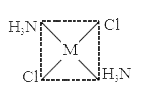Which of following isomers of [M(NH3)2Cl2] would react with silver oxalate (Ag2C2O4) :-


Both
None
The correct Answer is:A
To determine which isomer of (M(NH3)2Cl2) reacts with silver oxalate (Ag2C2O4), we need to analyze the structure of the isomers and the nature of the ligands involved.
1. Identify the Isomers:
The compound (M(NH3)2Cl2) can exist in two forms: cis and trans isomers. In the cis isomer, the similar ligands (NH3 or Cl) are adjacent to each other, while in the trans isomer, they are opposite.
2. Understand Ligand Types:
- Amine (NH3) and chloro (Cl) are monodentate ligands, meaning they can form one bond with the metal center.
- Oxalate (C2O2−4) is a bidentate ligand, which means it can form two bonds with the metal center.
3. Reactivity of Bidentate Ligands:
Bidentate ligands tend to replace monodentate ligands that are similar and adjacent to each other. Therefore, the oxalate ion will replace two similar ligands that are next to each other.
4. Analyze the Isomers:
- In the cis isomer, both NH3 or both Cl ligands are adjacent. This arrangement allows the oxalate ion to replace the two adjacent ligands.
- In the trans isomer, the similar ligands are opposite each other, which means the oxalate cannot effectively replace them.
5. Conclusion:
The cis isomer of (M(NH3)2Cl2) will react with silver oxalate (Ag2C2O4) because it has the required adjacent similar ligands for the bidentate oxalate to replace.
Final Answer:
The isomer that would react with silver oxalate (Ag2C2O4) is the cis isomer of (M(NH3)2Cl2).
The compound (M(NH3)2Cl2) can exist in two forms: cis and trans isomers. In the cis isomer, the similar ligands (NH3 or Cl) are adjacent to each other, while in the trans isomer, they are opposite.
- Amine (NH3) and chloro (Cl) are monodentate ligands, meaning they can form one bond with the metal center.
- Oxalate (C2O2−4) is a bidentate ligand, which means it can form two bonds with the metal center.
Bidentate ligands tend to replace monodentate ligands that are similar and adjacent to each other. Therefore, the oxalate ion will replace two similar ligands that are next to each other.
- In the cis isomer, both NH3 or both Cl ligands are adjacent. This arrangement allows the oxalate ion to replace the two adjacent ligands.
- In the trans isomer, the similar ligands are opposite each other, which means the oxalate cannot effectively replace them.
The cis isomer of (M(NH3)2Cl2) will react with silver oxalate (Ag2C2O4) because it has the required adjacent similar ligands for the bidentate oxalate to replace.
The isomer that would react with silver oxalate (Ag2C2O4) is the cis isomer of (M(NH3)2Cl2).
Topper's Solved these Questions
- BOOK - ALLENCHAPTER - INORGANIC CHEMISTRYEXERCISE - COORDINATION COMPOUNDS & d-BLOCK COMPOUNDS (MATCH THE COLUMN)2videos
INORGANIC CHEMISTRY
- BOOK - ALLENCHAPTER - INORGANIC CHEMISTRYEXERCISE - p-BLOCK ELEMENT80videos
INORGANIC CHEMISTRY
- BOOK - ALLENCHAPTER - INORGANIC CHEMISTRYEXERCISE - CHEMICAL BONDING119videos
INORGANIC CHEMISTRY
- BOOK - ALLENCHAPTER - HYDROGENEXERCISE - EXERCISE-517videos
HYDROGEN
- BOOK - ALLENCHAPTER - Ionic EquilibriumEXERCISE - All Questions37videos
Ionic Equilibrium
Similar Questions
Knowledge Check
- Question 1 - Select One
Consider the following isomers.
(i) [Pt(NH3)4Cl2]Br2 (ii)[Pt(NH3)4Br2]Cl2
(iii) [Co(NH3)4Cl2]NO2
Which of the following observations is correct ?A(i) will give a part yellow and (ii) will give a white precipitate with AgNO3 solution .B(iii) will give a white precipitate with AgNO3 solution .C(i) , (ii) and (iii) will give white precipitate with AgNO3 solution .DNone of the above isomers will give white precipitate with AgNO3 solution .
Which of the following will show optical isomers?
(I) cis-[Co(NH3)2(en)2]3+
(II) trans-[IrCl2(C2O4)2]3−
(III) [Rh(en)3]3+
(IV) cis-[IR(H2O)3Cl3]View SolutionWrite the IUPAC names of the following coordination compounds:
(a)[Pt(NH3)2Cl(NO2)]
(b) K3[Cr(C2O4)3]
(c) [CoCl2(en)2]Cl
(d) [Co(NH3)]Cl
(e) Hg[Co(SCN)4]View SolutionThe number of geometrical isomers for octahedral [Co(NH3)2Cl4]− and square planar [AuCl2Br2]− respectively are :
View SolutionIllustrate the geometrical isomers of [Pt(NH3)4Cl2]2+.
View SolutionThe number of geometrical isomers for octahedral [CoCl4(NH3)2]−, square planar [AgBr2Cl2]− and [PtCl2(en)] are:-
View SolutionGive the IUPAC names of the following compound [Ag(NH3)2]Cl
View SolutionName the type of isomerism exibited by the following isomers :
(1) [Cr(NH3)6][Cr(CN)6]and[Cr(NH3)4(CN)2][Cr(NH3)2(CN)4]
(2) [Co(py)2(H2O)2Cl2]Cland[Co(py)2(H2O)Cl3]H2O
(3) [Pt(NH3)4Br2]Cl2and[Pt(NH3)4Cl2]Br2
(4) [Co(NH3)5NO2]Cl2and[Co(NH3)5ONO]Cl2View Solution

